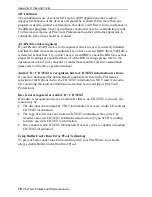
PlexTools Professional Reference Guide
75
Appendix C: Tips and Tricks
Auto Insert Notification
Auto Insert Notification is a function of the Windows 95/98/ME operating system. It
allows the notification of changes (eject or insert) of a CD in a drive. When this
happens, Windows will send a message to all programs in order to notify them that a
media change has taken place. This way, the programs know they have to check the
device for new disc contents. (Auto Insert Notification is not available for Windows
2000 or Windows XP.)
It is advisable to switch Auto Insert Notification on in order to allow PlexTools
Professional to take advantage of this function. When switched off, the Refresh
function (or Function key F5) can be used to manually allow the scanning for
changed media.
Autoplay Audio CDs
When Autoplay Audio CDs is enabled, this function can interfere with the proper
functioning of PlexTools Professional. Disabling this feature by unchecking the
checkbox in the Preferences selection of the Options menu may make PlexTools
Professional more stable.
Windows NT/Windows 2000/Windows XP without ASPI layer for SCSI devices
The use of ASPI software to control SCSI devices is vital for the Windows 95/98/Me
operating system. In general, the ASPI layer is a part of these systems and will be
installed during setup.
Windows NT, Windows 2000 and Windows XP can operate without the use of
ASPI, and these operating systems are shipped without ASPI software. After
installation of Windows, an ASPI layer can always be installed, which may improve
the performance of your SCSI system. Also, some applications will only work
through the use of ASPI commands and need a properly installed ASPI
configuration. The manufacturer of your SCSI controller is the first source for all
device drivers and ASPI software to be used with this controller.
ATAPI devices
To ensure the best performance from your Plextor ATAPI device it is recommended
that you install a busmaster driver for the IDE chipset of your system, and enable the
DMA capability of your drive in the operating system. (Go to Control Panel | Device
Settings.






































